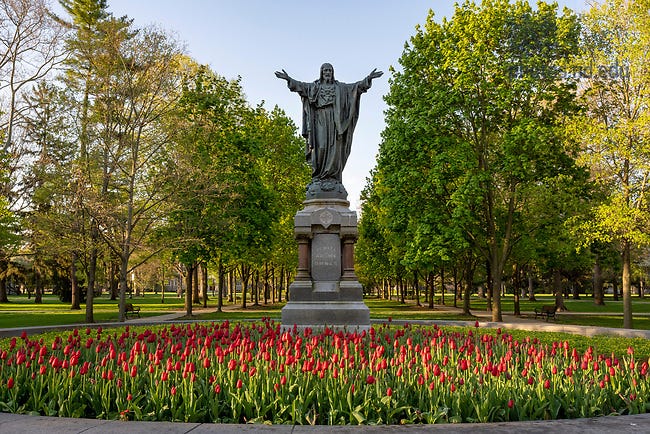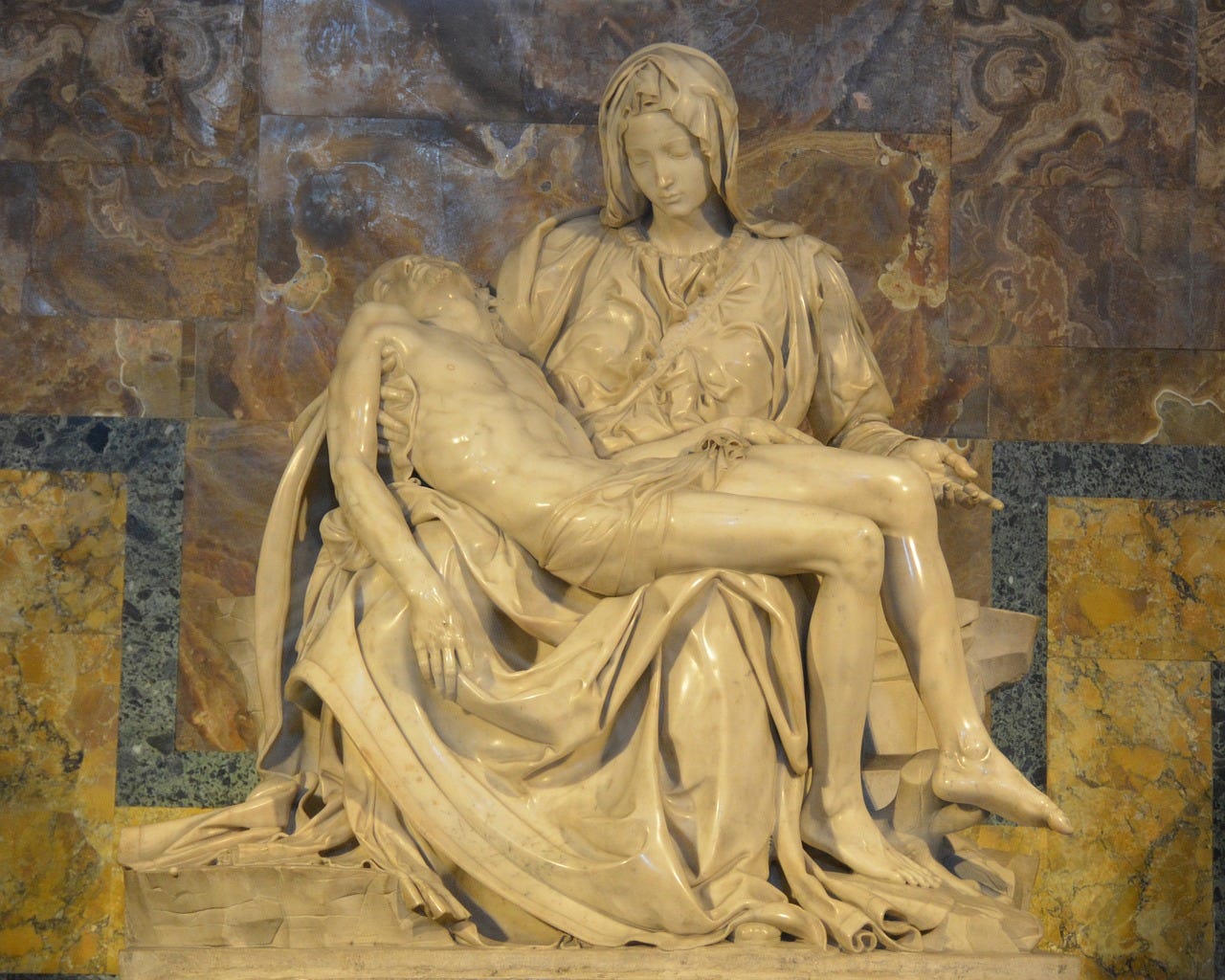Welcome back to A View from The Summit. The Summit Academy is a classical liberal-arts school rooted in the Catholic tradition, located in historic Fredericksburg, Va., serving students in grades 6-12. This newsletter informs readers about our school and the ways in which it is helping renew education and the Church.
He is Risen, alleluia! This special edition will replace, in observance of Easter, our usual every-other-Tuesday post. Those posts will resume on April 16.

The Summit is on break all week, and it’s time to celebrate. We are now in the Octave of Easter, during which each day is a mini Easter. We give thanks for Christ’s Resurrection, which changed everything for us. His perfect obedience on the Cross and His new life in the Resurrection opened for us the gates of Heaven. I want to share a few selections that have helped me in delving further into the mystery of our Lord’s Resurrection.
May All Rejoice
I’ll first share an excerpt from St. John Chrysostom’s Easter homily, traditionally read during Orthodox Easter services. (Credit here to Mother Natalia on Pints with Aquinas.)
Let all pious men and all lovers of God rejoice in the splendor of this feast; let the wise servants blissfully enter into the joy of their Lord; let those who have borne the burden of Lent now receive their pay, and those who have toiled since the first hour, let them now receive their due reward; let any who came after the third hour be grateful to join in the feast, and those who may have come after the sixth, let them not be afraid of being too late; for the Lord is gracious and He receives the last even as the first. He gives rest to him who comes on the eleventh hour as well as to him who has toiled since the first: yes, He has pity on the last and He serves the first; He rewards the one and praises the effort.
Come you all: enter into the joy of your Lord. You the first and you the last, receive alike your reward; you rich and you poor, dance together; you sober and you weaklings, celebrate the day; you who have kept the fast and you who have not, rejoice today. The table is richly loaded: enjoy its royal banquet.
May the Lord richly bless us all—those who are first and those who are last. Let those who toil not grow bitter at the rewards of others, and let those who are rewarded know the source and summit of their lives.
The Nature of the Resurrection
As we celebrate Easter, we might pray about the Resurrection: What was it, how do we know it’s Jesus, and what does it mean for us? We might begin by wondering what it was like for the apostles to encounter the risen Christ. The Gospels provide varied accounts of who encountered Him when, as well as the moment they realized they were encountering Jesus.
Mary Magdalen hearing her name, Thomas placing his hand in Christ’s wounds, and the disciples on the road to Emmaus recognizing Jesus when he gives thanks and breaks bread. If they were all close to Jesus during his ordinary life and public ministry, how is it that they did not recognize Jesus at the first moment? If it is truly Him, how could they not? Didn’t they know Jesus? On this point, it’s worth turning to one of the great theologians spiritual guides of our time, Pope Benedict XVI.
In his book Jesus of Nazareth: Holy Week, he describes the Resurrection like this: “Jesus’ Resurrection was about breaking into an entirely new form of life, into a life that is no longer subject to the law of dying and becoming, but lies beyond it—a life that opens up a new dimension of human existence.
“Jesus has not returned to a normal human life in this world,” Ratzinger writes, “like Lazarus and the others whom Jesus raised from the dead. He has entered upon a different life, a new life—he has entered the vast breadth of God himself, it is from there that he reveals himself to his followers.”
Further explaining this new reality, Ratzinger reflected on the Gospel accounts:
[F]or the disciples the Resurrection was just as real as the Cross. It presupposes that they were simply overwhelmed by the reality that, after their, initial hesitation and astonishment, they could no longer ignore that reality. It is truly he. He is alive; he has spoken to us; he has allowed us to touch him, even if he no longer belongs to the real of the tangible in the normal way.
The paradox was indescribable. He was quite different, no mere resuscitated corpse, but one living anew and forever in the power of God. And yet at the same time, while no longer belonging to our world, he was truly present there, he himself. It was an utterly unique experience, which burst open the normal boundaries of experience and yet for the disciples was quite beyond doubt. This explains the unique character of the Resurrection accounts: they speak of something paradoxical, of something that surpasses all experience and yet is utterly real and present (246).
Let us look in this Easter season for the new life to which Christ is calling us.
New Life and Our Happy Fault
Here’s a reflection from Magnificat by Sister Mary Jean Dorcy, O.P., who suggests ways in which we can stay close to this renewed life in Jesus.
In saying that many profited by the Redemption we do not exaggerate. Two gifts were given us at that great reconciliation: his Mother and the Mass. God might have arranged that Mary would be his Mother without making her ours also, but Christ gave her to us with his dying breath, and she is ours forever. Christ might also have redeemed us without instituting the Mass, but he willed to remain with us all days, and this was the way that his great love chose to do it . . .

Many famous artists have plied brush and chisel on the subject of the Pietà. No one has plumbed the depths of Mary’s sorrow at that moment, nor measured in the scope of God’s love expressed in that group in the shadow of the cross. Let us remember, those of us who have discovered to our surprise that living a Christian life in a pagan world is difficult, that here in the Pietà is an answer is we want one.
Here is Mary, Mother of all; here is the Mass, the sacrifice of Christ until the end of time. How understanding of God to seal forever our bond of friendship with such marvelous gifts, which, had man never sinned, we might never have had.
Oh, happy fault.
May we never forget the riches God has bestowed on us in His mercy. May we stay close to Mary and the Holy Mass, in which Christ continues to make Himself present to us for our salvation.
And, the Purpose of Education . . .
I can’t close this special edition without mentioning our shared mission in education. It is refreshing in times of rest and celebration to reflect on what we’re doing in our everyday work at school. Reading Education at the Crossroads (1960) by Catholic philosopher Jacques Maritain, I was struck by this passage in a footnote on page 24. The following was penned by Arthur Clutton-Brock, an English writer, in 1916:
Education ought to teach us how to be in love always and what to be in love with. The great things of history have been done by the great lovers, by the saints and men of science and artists; and the problem of civilization is to give every man a chance of being a saint, a man of science, or an artist. But this problem cannot be attempted, much less solved, unless men desire to be saints, men of science, and artists, and if they are to desire that continuously and consciously, they must be taught what it means to be these things.
This seems exactly right. As the school year comes to a close, may we endeavor never to lose sight of the beauty that is central to our work in education. Happy Easter!
If you are enjoying this newsletter, please consider subscribing via the button above and sending it along to others who might be interested. Revenue from paid subscriptions will support The Summit Academy of Central Virginia.


